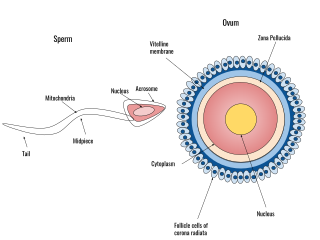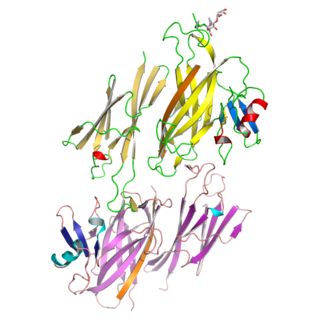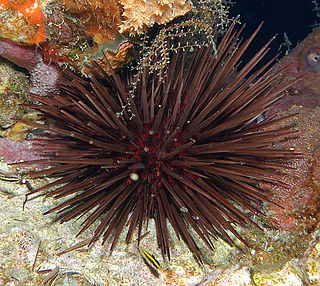Related Research Articles

A spermatozoon is a motile sperm cell, or moving form of the haploid cell that is the male gamete. A spermatozoon joins an ovum to form a zygote.

Fertilisation or fertilization, also known as generative fertilisation, syngamy and impregnation, is the fusion of gametes to give rise to a new individual organism or offspring and initiate its development. While processes such as insemination or pollination, which happen before the fusion of gametes, are also sometimes informally referred to as fertilisation, these are technically separate processes. The cycle of fertilisation and development of new individuals is called sexual reproduction. During double fertilisation in angiosperms, the haploid male gamete combines with two haploid polar nuclei to form a triploid primary endosperm nucleus by the process of vegetative fertilisation.

During fertilization, a sperm must first fuse with the plasma membrane and then penetrate the female egg cell to fertilize it. Fusing to the egg cell usually causes little problem, whereas penetrating through the egg's hard shell or extracellular matrix can be more difficult. Therefore, sperm cells go through a process known as the acrosome reaction, which is the reaction that occurs in the acrosome of the sperm as it approaches the egg.
An oocyte, oöcyte, or ovocyte is a female gametocyte or germ cell involved in reproduction. In other words, it is an immature ovum, or egg cell. An oocyte is produced in a female fetus in the ovary during female gametogenesis. The female germ cells produce a primordial germ cell (PGC), which then undergoes mitosis, forming oogonia. During oogenesis, the oogonia become primary oocytes. An oocyte is a form of genetic material that can be collected for cryoconservation.

The zona pellucida is a specialized extracellular matrix that surrounds the plasma membrane of mammalian oocytes. It is a vital constitutive part of the oocyte. The zona pellucida first appears in unilaminar primary oocytes. It is secreted by both the oocyte and the ovarian follicles. The zona pellucida is surrounded by the corona radiata. The corona is composed of cells that care for the egg when it is emitted from the ovary.
Capacitation is the penultimate step in the maturation of mammalian spermatozoa and is required to render them competent to fertilize an oocyte. This step is a biochemical event; the sperm move normally and look mature prior to capacitation. In vivo, capacitation occurs after ejaculation, when the spermatozoa leave the vagina and enter the upper female reproductive tract. The uterus aids in the steps of capacitation by secreting sterol-binding albumin, lipoproteins, and proteolytic and glycosidasic enzymes such as heparin.

Acrosin is a digestive enzyme that acts as a protease. In humans, acrosin is encoded by the ACR gene. Acrosin is released from the acrosome of spermatozoa as a consequence of the acrosome reaction. It aids in the penetration of the Zona Pellucida.
External fertilization is a mode of reproduction in which a male organism's sperm fertilizes a female organism's egg outside of the female's body. It is contrasted with internal fertilization, in which sperm are introduced via insemination and then combine with an egg inside the body of a female organism. External fertilization typically occurs in water or a moist area to facilitate the movement of sperm to the egg. The release of eggs and sperm into the water is known as spawning. In motile species, spawning females often travel to a suitable location to release their eggs.

Human fertilization is the union of an egg and sperm, occurring primarily in the ampulla of the fallopian tube. The result of this union leads to the production of a fertilized egg called a zygote, initiating embryonic development. Scientists discovered the dynamics of human fertilization in the 19th century.
In biology, polyspermy describes the fertilization of an egg by more than one sperm. Diploid organisms normally contain two copies of each chromosome, one from each parent. The cell resulting from polyspermy, on the other hand, contains three or more copies of each chromosome—one from the egg and one each from multiple sperm. Usually, the result is an unviable zygote. This may occur because sperm are too efficient at reaching and fertilizing eggs due to the selective pressures of sperm competition. Such a situation is often deleterious to the female: in other words, the male–male competition among sperm spills over to create sexual conflict.

The cortical reaction is a process initiated during fertilization that prevents polyspermy, the fusion of multiple sperm with one egg. In contrast to the fast block of polyspermy which immediately but temporarily blocks additional sperm from fertilizing the egg, the cortical reaction gradually establishes a permanent barrier to sperm entry and functions as the main part of the slow block of polyspermy in many animals.
The vitelline membrane or vitelline envelope is a structure surrounding the outer surface of the plasma membrane of an ovum or, in some animals, the extracellular yolk and the oolemma. It is composed mostly of protein fibers, with protein receptors needed for sperm binding which, in turn, are bound to sperm plasma membrane receptors. The species-specificity between these receptors contributes to prevention of breeding between different species. It is called zona pellucida in mammals. Between the vitelline membrane and zona pellucida is a fluid-filled perivitelline space.

Sialyl LewisX (sLeX), also known as cluster of differentiation 15s (CD15s) or stage-specific embryonic antigen 1 (SSEA-1), is a tetrasaccharide carbohydrate which is usually attached to O-glycans on the surface of cells. It is known to play a vital role in cell-to-cell recognition processes. It is also the means by which an egg attracts sperm; first, to stick to it, then bond with it and eventually form a zygote.

Zona pellucida sperm-binding protein 3, also known as zona pellucida glycoprotein 3 (Zp-3) or the sperm receptor, is a ZP module-containing protein that in humans is encoded by the ZP3 gene. ZP3 is the glycoprotein in the zona pellucida most important for inducting the acrosome reaction of sperm cells at the beginning of fertilization.

Zona pellucida sperm-binding protein 2 is a protein that in humans is encoded by the ZP2 gene.

The Atlantic purple sea urchin is a species of sea urchins from the family Arbaciidae, native to the Atlantic Ocean.
Sperm guidance is the process by which sperm cells (spermatozoa) are directed to the oocyte (egg) for the aim of fertilization. In the case of marine invertebrates the guidance is done by chemotaxis. In the case of mammals, it appears to be done by chemotaxis, thermotaxis and rheotaxis.
Sperm chemotaxis is a form of sperm guidance, in which sperm cells (spermatozoa) follow a concentration gradient of a chemoattractant secreted from the oocyte and thereby reach the oocyte.
Oocyteactivation is a series of processes that occur in the oocyte during fertilization.
Paul Michael Wassarman is an American biologist who has been Professor in the Dept. of Cell, Developmental, and Regenerative Biology at the Icahn School of Medicine at Mount Sinai since 1996. His laboratory identified and characterised proteins that make up the zona pellucida (ZP) of mammalian eggs and determined their role in fertilisation.
References
- 1 2 3 4 Wessel, GM; Brooks, JM; Green, E; Haley, S; Voronina, E; Wong, J; Zaydfudim, V; Conner, S (2001). "The biology of cortical granules". International Review of Cytology. 209: 117–206. doi:10.1016/s0074-7696(01)09012-x. ISBN 9780123646132. PMID 11580200.
- 1 2 Farley, Gregory S.; Levitan, Don R. (June 2001). "The Role of Jelly Coats in Sperm-Egg Encounters, Fertilization Success, and Selection on Egg Size in Broadcast Spawners". The American Naturalist. 157 (6): 626–636. doi:10.1086/320619. ISSN 0003-0147. PMID 18707279. S2CID 8313431.
- 1 2 Inamdar, Munish V.; Kim, Taeyong; Chung, Yao-Kuang; Was, Alex M.; Xiang, Xinran; Wang, Chia-Wei; Takayama, Shuichi; Lastoskie, Christian M.; Thomas, Florence I. M.; Sastry, Ann Marie (1 November 2007). "Assessment of sperm chemokinesis with exposure to jelly coats of sea urchin eggs and resact: a microfluidic experiment and numerical study". The Journal of Experimental Biology. 210 (Pt 21): 3805–3820. doi: 10.1242/jeb.005439 . PMID 17951422 . Retrieved 8 September 2014.
- ↑ Turani, Blerta; Aliko, Valbona; Faggio, Caterina (2020-03-18). "Allurin and egg jelly coat impact on in-vitro fertilization success of endangered Albanian water frog, Pelophylax shqipericus". Natural Product Research. 34 (6): 830–837. doi:10.1080/14786419.2018.1508147. ISSN 1478-6419. PMID 30445855. S2CID 53569696.
- ↑ Hoshi, M; Nishigaki, T; Ushiyama, A; Okinaga, T; Chiba, K; Matsumoto, M (1994). "Egg-jelly signal molecules for triggering the acrosome reaction in starfish spermatozoa". The International Journal of Developmental Biology. 38 (2): 167–174. PMID 7981026.
- ↑ Foo, Shawna A.; Deaker, Dione; Byrne, Maria (2018-07-01). "Cherchez la femme – impact of ocean acidification on the egg jelly coat and attractants for sperm". The Journal of Experimental Biology. 221 (13): jeb177188. doi: 10.1242/jeb.177188 . ISSN 0022-0949. PMID 29674376.